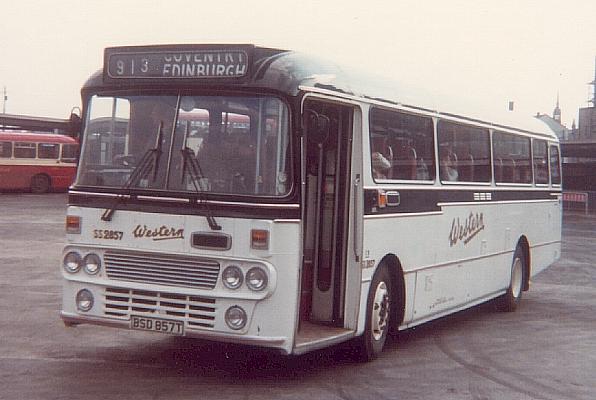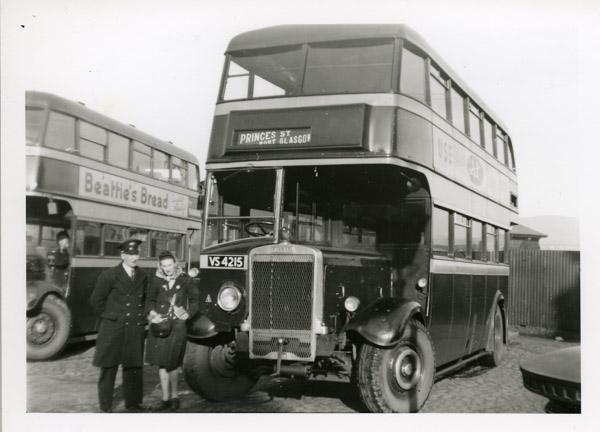Whilst this website is primarily intended to cover Western Scottish Omnibuses Ltd history, it’s also important to document where it all began, how the company expanded through the decades and eventually became part of the Scottish Bus Group.
A Long time ago….
The first chapter in the story of Western SMT was written on June 1st, 1882, with the opening of the Isle of Bute lines of the Rothesay Tramway Co Ltd. In 1913, British Electric Traction placed Rothesay Tramways, the Greenock and Port Glasgow Tramways Company (opened in 1889), and the Airdrie & Coatbridge Tramways Company (opened in 1904), and shares in motor operator McKirdy and McMillan of Rothesay in the hands of the newly formed Scottish General Transport Co Ltd. It was based at Bothwell and had primary responsibility for the operation and development of feeder bus services.
The Airdrie and Coatbridge trams passed to a local authority trust in 1920 and to Glasgow Corporation in 1922. The other two companies remained in existence as bus operators until 1949 when the British Transport Commission decreed that Western’s subsidiary companies by wound up. The Greenock company was renamed Greenock Motor Services in 1928, trams being withdrawn the following year, while Rothesay’s largely open-sided cars lasted until September 1936, nine months after McKirdy and McMillan was wound up.
SGOC adopted Scottish Transport as it’s trading name, but suffered some hiccups before establishing itself in Ayrshire and to the South West of Glasgow. In 1919 / 1920, for instance, six AEC Y’s ran on a route across Stirling from Bannockburn to Dunblane, whilst competition with Lanarkshire Tramways ended by agreement in 1925 when headquarters were moved to Kilmarnock bus station.
Once settled in its niche, Scottish Transport embarked upon a programme of expansion with the development of new services and the construction of depots and bus stations.
It was renamed Western SMT Co Ltd in June 1932, seven months after the Edinburgh based SMT group had taken over BET’s interest in the undertaking, and it was decided speedily to merge local SMT and LMS Railway interests with the newly formed company.
This followed a period of some uncertainty when some buses had been painted SMT blue, others Scottish Transport red , and others still in the various schemes of SMT owned Midland bus services of Airdrie. Midland had been formed in 1924 by John Sword, an entrepreneur who had caught the eye of SMT and who was appointed first director and general manager of Western, Sword’s endeavours helped the British bus industry to change from petrol to diesel engines, and his belief in the possibilities of air transported to the formation of Midland and Scottish Air Ferries Ltd in 1933, a company which used Western SMT’s livery during it’s four year life. Midland’s Airdrie area services passed to SMT itself in 1935 when company boundaries were revised. LMSR’s buses ran mostly around Greenock and had grown in number through acquisition of smaller businesses. Added to these, SMT had acquired Ferguson (Victoria) of Renfrew, and Muirhead (Stanley) of Glasgow in 1931, Ayr Corporation Tramway’s services, Kilmarnock Corporation, Airways Motor Services, Finland of Ayr, and Pyefinch of Greenock in 1932, all passing to Western upon it’s formation. The licences for the Ayr Corporation services were not transferred from Scottish Omnibuses until 1963.
Western’s position was strengthened by the acquisition of Graham of Linwood, Ayr and District, Liddell of Auchenleck, Carrick Pullman (McGill) of Crosshill, and Currie and Thomson of Calderbank in 1932, Shankland and Gardiner of Paisley in 1938, and Down Motor Services of Ayr in 1939. Dunlop of Greenock became a Western subsidiary in 1945, but lost it’s identity upon nationalisation in 1949.

The 138 buses of former Tilling Group Caledonian Omnibus Company passed to Western in January 1950 along with most of the company’s services and depots. Caledonian, based at Dumfries, was formed in 1927 to acquire the businesses of five operators in the counties of Dumfries, Kirkcudbright and Wigtown, and went on to build up activities throughout south west Scotland and north of Carlisle. Western’s last major takeovers were in 1950 and 1951 when Paisley and District Omnibus Company and it’s parent Young’s Bus Services were acquired with 130 buses and services within Paisley and between Glasgow and the Clyde Coast. Few have followed, only Glasgow Corporation’s two Paisley locals being acquired in 1955, Rothesay Motor Services and Clark of Glencaple in 1965, Murray of Stranraer in 1966, Smith of Barrhead (Scottish CMS subsidiary) in 1968, and the Glasgow Mid Argyll routes of David McBrayne in 1970. Only the MacBrayne takeover increased the permanent fleet strength, four small Bedfords being taken for local services. These were numbered in a separate series, and the oldest was bought by Campbell of Lochgoilhead in 1973 when the Carrick Castle Rest and be Thankful service was relinquished.
Western undertook little extended tour work, but compensated for this by serving as the Scottish Bus Group’s principle long distance operator in the west of Scotland. The Glasgow – London route was the jewel in the company’s crown, it having begun in it’s present form in 1929 when SMT prompted Midland to introduce a route via Carlisle and Scotch Corner to the erstwhile London Coastal terminal at Lupus Street, Pimlico. The opening of Victoria Coach Station was marked by the introduction of diesel propulsion, and under Western control, the business of Premier Line of Watford was acquired in 1933. High standard coaches with generous leg room and toilet facilities have been operated since the 1930’s including Bristol REMH’s and Volvo B58’s with Alexander M type coachwork.

Later the service was extended to serve Dumfries, Galloway and Renfrewshire, while the Alexander (Northern) Aberdeen – London service was developed from the Glasgow route. Joint service with Ribble to Lancashire began in 1930 whilst this expanded to encompass joint expresses to the West Midlands, East Midlands, East Anglia, the West Country, and the north of Ireland. Insurance considerations, at the time, ruled that Western worked only the Edinburgh / Glasgow to Stranraer sections of the Irish services with Ulsterbus and Lough Swilly provided connections from Belfast and Larne.
In March 1985 the Western SMT Company Ltd became a bus operating subsidiary of the Scottish Transport Group and was renamed Western Scottish Omnibuses Ltd.

